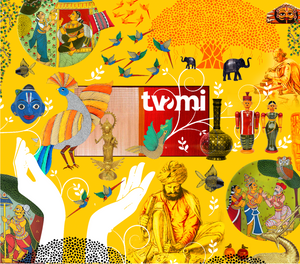
Sital Fouzdar
-

 Original price ₹3,999.00 - Original price ₹3,999.00Original price ₹3,999.00₹3,999.00₹3,999.00 - ₹3,999.00Current price ₹3,999.00| /
Original price ₹3,999.00 - Original price ₹3,999.00Original price ₹3,999.00₹3,999.00₹3,999.00 - ₹3,999.00Current price ₹3,999.00| /Vishnu Dasavatar Ganjifa Cards from Bengal (set of 10)
Sital Fouzdar
Made to order. Making time: 14 days1 reviewBehold Lord Vishnu’s 10 distinct avatars when he descended on the earth to save mankind from the evil in different aeons. Handpainted by artisan Si...
View full detailsOriginal price ₹3,999.00 - Original price ₹3,999.00Original price ₹3,999.00₹3,999.00₹3,999.00 - ₹3,999.00Current price ₹3,999.00| /
Bishnupur is famous for its terracotta temples built by the Malla rulers in Bengal and has thus become a hub for terracotta craft. Ganjifa is truly an ancient art form and as proof if that, Fouzdar is an 89th generation artist who has inherited the skills through lineage. While Ganjifa has its origins in the Mughal era through the Persian route, it evolved to cater to Indian cultures by imbibing stories from religious scriptures.
Sital has a fascinating history of his own. His ancestors were Rajasthani mercenary warriors who settled in Bengal and Orissa. The king of Orissa discovered their talents for fine drawings and since then the Fouzdar family has been making Ganjifa playing cards for the military. They practised the Patachitra style.
He claims to be one of the four practising artisans in present day India. He learnt the craft from his Paternal uncle who was an award-winning artist. At 15, he took his first international trip to London for an exhibition organized by the Government of India. It was there that he realised that no one wanted to buy the entire set of 100 cards because they did not fully understand the game and cultural significance. He then decided to break up the set to make it affordable, accessible and a form of memorabilia. This idea worked and he was able to sell most of the cards.
One of Sital’s specialties is the characterization of Lord Jagannath with hands to represent warriors (usually he does not have hands). There are two types of cards he paints; a set of 10 cards with Hindu symbols and deities & a set of 12 cards with Mughal motifs and queen. However, there are still a few craft patrons who wish to purchase the whole set of 100 cards. These are packed in a hand-painted wooden case.
Although he has a teenage son and daughter, his nephew will most likely be his successor. Till the last generation, the craft was their primary source of income. With changing lifestyles, growing prospects of education in the family, rise in cost of living and decline in demand for ganjifa products, Sital’s family members practice other jobs too. They also make deities and draw patachitra on other mediums.
His collections are housed at the Craft Council of India in Delhi and Kolkata and he showcases his work at some of the most prestigious craft exhibitions in India and abroad.
His house is a brick and mortar one- small but stable. Everyone in Bishnupur town knows him. The thin lanes tell a story of pride, struggles and an uncertain future of Ganjifa. Sital does not believe that the awards doled out by the government are fully authentic. He is hopeful about the craft’s future if his nephew takes up the reigns of his craft. More than the income, he finds purpose in the love and appreciation of art forms. One of his paintings hangs in the royal palace at Goa and travels overseas to exhibit his craftsmanship.
One of the challenges to his work used to be that people would try and sell his art as their own since he never signed them. When he tried adding his signature, buyers did not like it. He then devised an alternative of adding his signature within the painting itself, hidden as a part of it in curls of the woman’s hair or a pallu border of a sari. “You must understand, authenticity is important in our field of work.”, he says.




